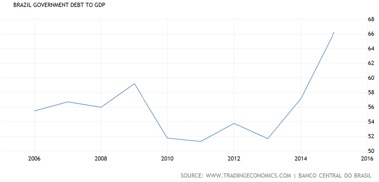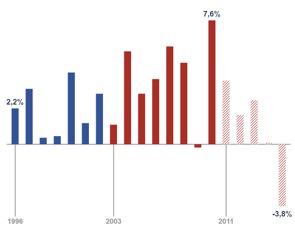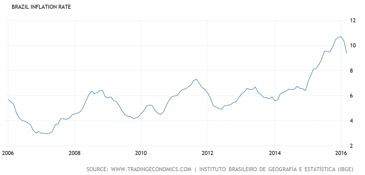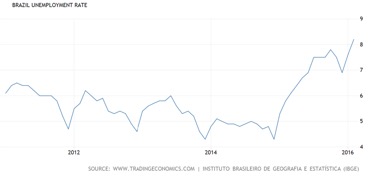Brazilian Challenges: Untying Political and Economic Knots
04/25/2016
To revert current economic trends, Brazil will need a stable governing coalition that is willing to face reality and implement a reformist agenda.

RISE OF THE WORKER’S PARTY
In a November 2003 report called “Dreaming with BRICs: The Path to 2050”[1], Goldman Sachs predicted that Brazil, Russia, India and China could become dominant forces in the world economy. The expectation was that Brazil’s GDP growth rate would average 3.6% over the next 50 years. This optimistic view was based on a key assumption, that Brazil would maintain policies that were supportive of growth.
The paper was released during Lula’s first year in office and it acknowledged the progress made by his administration. In 2002, investors were afraid that a leftwing victory could drive Brazil off the rails [2]. However, when Lula was elected president, his appointments for the head of the Central Bank and the Minister of Finance made it clear to investors that he would respect market disciplines. During his first term, Lula strengthened welfare projects which reduced poverty. He also implemented economic policies that were a continuation of Cardoso’s economic policies, which focused on primary fiscal surplus, targeting inflation, and flexible exchange rate regime.
The ruling Worker’s Party (PT) faced its first corruption scandal in 2005. The “Mensalão” was a corruption scheme that used public funds to pay coalition parties for political support and sentenced to jail prominent figures such as Jose Genoino, PT ex-president, and Jose Dirceu, Lula’s former chief of staff. Lula was not implicated in the case and left the office in 2010 with a stunning 87% approval rate and an average GDP growth rate of 4.6% [3]. Following Lula’s popularity, Dilma Rousseff, his former Chief of Staff who had never held elected office before, won the 2010 presidential election.
ECONOMIC SLOWDOWN
The slowdown of Brazilian economic growth started in 2011. According to Alexandre Schwartsman [4], former Central Bank director, the government reacted to this slowdown through an over-stimulus on the demand side of the economy while ignoring weak productive capacity. Federal banks lent piles of money at below-market rates to investments, which eventually failed to pay long-term returns. As a result of excessive expenditures, government debt reached new levels – around 70% of GDP – with interest rates reaching levels as high as 14%. This policy pressured inflation, which was handled by the government through price controls that damaged companies such as Petrobras.

Domestic economic policies and changes in the external conditions, coupled with China’s slowing growth and falling commodities prices, put the Brazilian economy in a recession in 2014. Again, however, in 2014, Dilma Rousseff was re-elected president in the closest presidential election race in years [5].
POLITICAL TURBULENCE
President Dilma Rousseff faces a combination of an economic crisis and political turmoil during her second term. In 2015, GDP decreased by 3.8% and is expected to shrink again in 2016. Inflation and unemployment rate are both hovering around 10% and many believe this is the worst recession in a long time. Marcos Troyjo, a former Brazilian diplomat and co-director of the BRICLab at Columbia University, said that “We went from Brazil mania to Brazil nausea. We are looking at a lost decade, where growth stagnates, inflation is high, and, most sadly, a decade where you’ve learned nothing.”

GDP Growth (annual %) – Jornal O Globo


The second corruption scandal faced by the Worker’s Party fueled a country that was already divided. In the bribery scheme, senior figures at state-oil giant Petrobras conspired with construction companies to inflate contracts and funnel the extra revenue to political parties to fund election campaigns. During the investigation known as “Carwash Operation”, dozens of high-profile politicians and executives have been caught up for bribery and money laundering. Ms. Rousseff was chairwoman of Petrobras from 2003 until 2010 but there is no evidence of illegal actions on her part. Although strongly supported by the public, the Carwash Operation is accused by some people for been politically motivated.
However, the ongoing impeachment process against Ms. Rousseff is not related to the Carwash Operation. The request contends that Dilma Rousseff violated fiscal laws by using funds from state banks to cover budget deficits. The so-called “pedaladas fiscais” (accounting gimmicks) is the delay in transfers by the National Treasury to state banks, thereby artificially boosting the health of public finances. The Brazilian audit court rejected Rousseff budgetary accounts, considering that “pedaladas” violated the Law of Fiscal Responsibility [6].
On April 17th, Brazil’s Lower House of Congress voted to send the case against Ms. Rousseff to the Senate. If the impeachment motion is approved there, Rousseff will have to step down for 180 days and defend herself from the accusations of wrongdoing. This could take place in early as May and Rousseff would be suspended just a few months before the Olympics in Rio de Janeiro.
The president’s supporters contend that Ms. Rousseff is a victim of a coup-d’état from people who failed to beat her in the 2014 election. However, some Supreme Court justices recently said that her impeachment was in accordance with the constitution, an assertion Ms. Rousseff declined to rebuff [7]. A recent poll showed that 61% of Brazilians think Ms. Rousseff should be removed from office [8]. Nowadays, her approval rating is around 13% [9].
BRAZILIAN CHALLENGES
The failure of Brazil’s political class is alarming. 60% of Brazil’s Congress face investigation of criminal wrongdoing. Mr. Cunha, speaker of the lower house of Congress and leader of the impeachment motion, is accused of funneling away $5 million into Swiss bank accounts. Prominent figures such as former president Lula and opposition leader Aécio Neves are under investigation. The vice-president Michel Temer faces strong resistance from the public [8]. Thus, it is unlikely that the imminent president departure will be enough to definitely put the country on the right path.
However, Dilma’s ousting seems to be a necessity. Brazil must curb public spending, reduce inflation and rebalance the public account, which can only be achieved through a reformist agenda. At this point the market is not confident that the Worker’s Party could go down this road.
It is unclear if Brazil can implement such reforms at all. The political system is so fragmented that it will be hard to gather support from Congress for changes that, although beneficial in the long-run, may be unpopular in the short-term. Also, it is uncertain whether the Brazilian society would embrace changes such as a labor reform or a pension system reform.
To revert current economic trends, Brazil will need a stable governing coalition that is willing to face reality and implement a reformist agenda. Does Brazil have such political leadership? Is it possible to go to the streets with a reformist speech and get elected? Answers to these questions can give a good perspective on what’s next. Unless significant progress is made in untying the political knot, an economic recovery is unlikely to be achievable.
References:
INSTITUTO BRASILEIRO DE GEOGRAFIA E ESTATÍSTICA. www.ibge.gov.br.
BANCO CENTRAL DO BRASIL. www.bcb.gov.br.
INSTITUTO DE PESQUISA ECONÔMICA APLICADA – IPEADATA. www.ipeadata.gov.br.
ARESTIS, P.; FERRARI FILHO, F.; PAULA,L.F. (2006), “Assessing the economic policies of President Lula in Brazil: Has fear defeated hope?”. Working Paper CBS-81-07
[1] http://www.goldmansachs.com/our-thinking/archive/archive-pdfs/brics-dream.pdf
[2] Smith, T. (2012, September 24). Markets in Brazil Plunge On Worries Over Election. The New York Times.
[3] Phillips, T. (2010, December 31). Lula era comes to an end in Brazil. The Guardian.
[4] http://maovisivel.blogspot.com/2016/03/oito-anos-em-tres.html
[5] Welsh, T. (2014, October 27). Brazil Likely to Continue Interventionist Economy Under Rousseff. U.S. News
[6] Edgerton, A. (2015, October 7). Rousseff Suffers Another Body Blow on Accounting Rejection. Bloomberg.
[7] Trevisani, P. (2016, April 22). Brazil’s Rousseff: Impeachment Process Has ‘All the Features of a Coup’. The Wall Street Journal.
[8] Canzian, F. (2016, April 9). Maioria quer que Dilma e Temer saiam, mostra pesquisa Datafolha. Folha de S. Paulo
[9] Opinião Pública. (2016, April 11). Reprovação à gestão Dilma recua e volta a nível pré-manifestação. Datafolha
